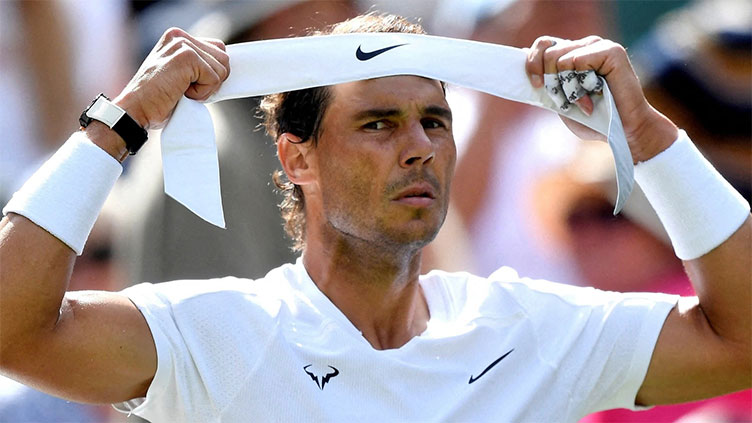After long fight for glory, Nadal leaves with a legacy of memories

Sports
Rafael Nadal was not only the "king of clay" but also reigned on every other tennis surface.
BARCELONA (AFP) – Rafael Nadal, who announced his retirement at the age of 38 on Thursday, was not only the "king of clay" but also reigned on every other tennis surface as he accumulated 22 Grand Slam titles.
Nadal's even-keeled and humble demeanour, on and off the court, endeared him to fans. While his defining quality was a grim ability to tough out marathon wins, he clearly enjoyed playing and competing and showed humility in victory and poise in defeat.
"The important legacy is that all the people I have met during these 20 years have a good human memory of me," he said.
"At the end of the day, the personal issue, education, respect and the affection you can treat people with comes before the professional issue, because that is what remains."
Nadal was born on the island of Mallorca in June 1986. His father Sebastian was a businessman, his mother Ana gave up working to raise her children.
After his parents separated when Nadal was an adult he told the Guardian in 2009: "My parents' divorce made an important change in my life."
One of his uncles, Miguel Angel Nadal, played professional football for Barcelona, although Rafa grew up to be a Real Madrid fan.
As a child, Nadal played football in the streets of his hometown of Manacor, before focussing on tennis under the coaching of another uncle, Toni Nadal, who guided his career from 2005 to 2017.
Nadal played both forehand and backhand with two hands until he was about 10.
"There are no professional players who play with two hands and we're not going to be the first, so you've got to change," Toni Nadal was quoted as saying in the 2012 book 'So you want to win Wimbledon' by Martin Baldridge.
'SUPER-AMBITIOUS'
Nadal eats, throws and plays golf and basketball right-handed though he is left-sided in football.
"When we started playing the forehand one-handed, he did so with the left," said Toni Nadal. "It is still astonishing."
Toni Nadal, spotting the child's potential, worked him relentlessly to develope endurance and shot making.
"First hit the ball hard then we'll see about keeping it in," Toni Nadal said he told the youngster.
Nadal's ferocious top-spin forehand was to become his trademark shot.
Nadal's family refused to let the talented youngster leave home.
"If you ask a father if he'd prefer to see his son become Roland Garros champion rather than a well brought up kid, he'd choose the first option," Toni Nadal said.
His uncle's focus on attitude shaped Nadal.
"When I was young my uncle said to me, if you throw your racquet I will stop coaching you," Nadal said. "If I make a bad shot, it is my fault - not the racquet's.
Fellow Mallorcan Carlos Moya was impressed by the youngster.
"I could see, by the sheer intensity with which he trained, that he was super-ambitious and desperate to improve. He hit every shot as if his life depended on it," said Moya.
Nadal turned professional at 14 and made his Wimbledon debut in 2003 at 17.
At 18, Nadal was part of the Spanish team that won the Davis Cup, playing, and winning, one singles match in the final.
Nadal won his first major title at his first French Open, two days after turning 19. He won his last, a 14th Roland Garros title, 17 years later.
As a youngster, he played in tank tops that showed off his bulging arms and kept his hair in place with bandanas.
"I've decided to put my muscles away," he told the lifestyle site Life Beyond Sport. "Sleeveless T-shirts give you real freedom of movement and they keep you cooler in matches, but I just thought it was time for a change. I do love a headband... I've got dozens of them in lots of different colours."
Nadal amassed titles despite playing in an era which also boasted Roger Federer and Novak Djokovic, tennis's dominant "big three" for more a decade.
His scrappy baseline style contrasted with the elegance of Federer and the all-round game of Djokovic.
Federer faced Nadal in 14 Grand Slam finals winning only four, the Swiss player ending his career with 20 majors, two less than the Spaniard.
'GLORY IS BEING HAPPY'
Nadal's physical playing style took a toll. He was plagued by injuries but kept fighting back. After the second half of his 2021 season had been wiped out, he returned to break Federer's record at the 2022 Australian Open and added a 22nd major at the French Open just after his 36th birthday.
"If you don't lose, you can't enjoy victories. You have to accept both things," Nadal posted on his personal website.
After that victory, he told CNN that he was not concerned if Djokovic broke the record.
"It's something that does not bother me if Novak wins 23 and I stay at 22. I think my happiness will not change at all, not even one per cent."
Djokovic won three titles the following year to take his total to 24.
Nadal started dating Mery when he was 19 and they married in 2019. They had their first child, Rafael, in 2022.
"I love the sea," he has said repeatedly. He owns a yacht and likes fishing.
"Glory is being happy," he was quoted as saying on his tennis academy web site in 2021. "The glory is not winning here or winning there. The glory is enjoying practicing, enjoy every day, enjoying to work hard, trying to be a better player than before."



